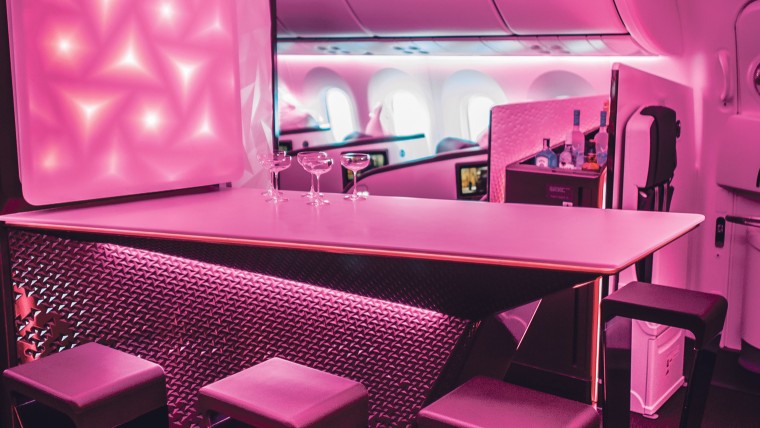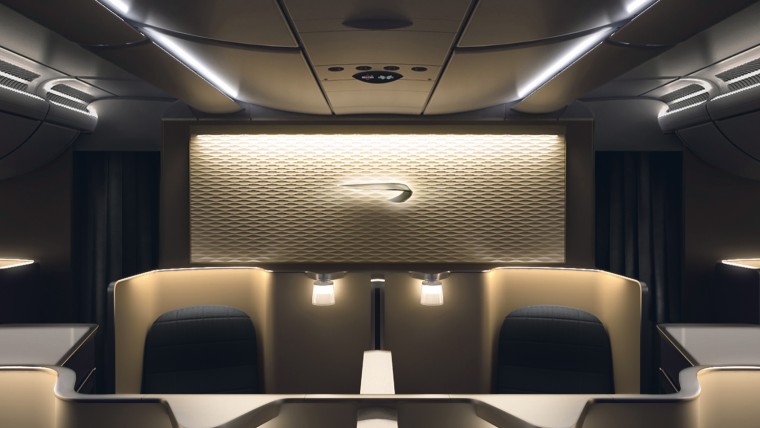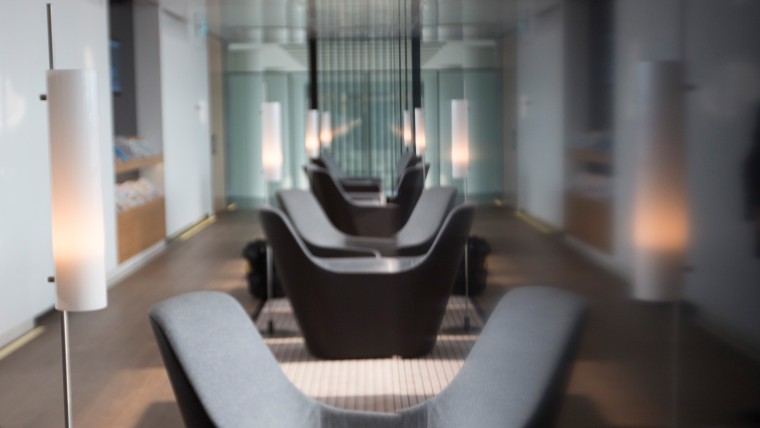Ten years ago, it seemed first class was heading the way of smoking sections, Pan Am and Concorde. The airline industry was in a parlous state and new product was focused on elevated, premium twists on economy class rather than those four or five seats in the nose.
The 2008 economic crisis did plenty to compound the misery. But canny partnerships over the last decade – Delta and Virgin Atlantic; Air France and KLM; Qantas and Emirates – and the introduction of the Airbus A380 have led to robust innovation in first class.
For some, notably the Middle-Eastern airlines, the product isn’t just an incentive for upgrade for loyal flyers or a photogenic marketing opportunity, it’s a way to keep chief executives and high-net-worth travellers off private jets and on their biggest birds.
“First-class product has been a key focus for the airline since it started flying in 2003,” says a spokesperson for Etihad, which is currently installing its groundbreaking Residence by Etihad concept – a three-room, 125-square-foot cabin, with bedroom, shower room and lounge – in new A380s. Passengers are also assigned their own personal butler, trained at the Savoy Butler Academy in London. No flight could be long enough to enjoy it all.
Etihad is also offering two other variants on first class. Its First Apartments on the A380, configured along a single aisle, have a 30.3-inch lounge chair and separate full-length ottoman, which converts into an 80.5-inch-long, 26-inch-wide, fully flat bed. While the First Suite on the new Boeing 787 Dreamliner has a single seat that converts into the same size of bed.
Qatar is also rolling out a new product. “The latest developments can be found on our new A380s, which began flying between Heathrow and Doha after delivery last October,” says Richard Oliver, Qatar’s country manager for UK and Ireland. “First-class passengers have access to two large dressing rooms with oversized sinks, seats have a 90-inch pitch and the in-flight entertainment incorporates a cutting-edge dual-screen system. The 26-inch high-definition LED screen has the highest LED resolution on any aircraft in the world. An intuitive 3.8-inch touch-screen control unit lets passengers choose intuitively and create playlists with a simple tap or swipe.”
The Airbus A380 has become the stage that allows for major productions in first class
The “soft” product is similarly high-end: Nobu and Vineet Bhatia are name-dropped on the menus, and the champagne is Krug. But this won’t be available across the whole fleet. “As part of our business strategy, first class is being phased out on all new aircraft being delivered to the airline apart from the Airbus A380,” says Mr Oliver.
The Airbus A380 has become the stage that allows for major productions in first class. It may indeed have rescued the whole concept, although Virgin Atlantic still focus on their Upper Class product, initially conceived as superior to international business class, while suggesting the redundancy of traditional first class. “We are currently introducing a redesigned Upper Class cabin on our 787 aircraft,” says Debbie Hulme, head of customer experience at Virgin Atlantic. “The first aircraft arrived in October and we will take delivery of a further 20 by 2018.”

Virgin Atlantic Upper Class bar, redesigned for the A380, with LED lighting
The refreshed look includes seating with a “geisha white and mica” finish, and a redesigned bar (British Airways, notably, has no bar on its A380s for business or first-class passengers), with a Corian surface, a layout that allows for two passengers to dine and sophisticated LED lighting to create a variety of moods.
For airlines upgrading their first-class concepts, the ultra-private cabin is the model that everyone seems to be following. Singapore Airlines, for example, has created new first-class product for the largest planes in its fleet and it’s getting a lot of use. “Across much of our long-haul network and even on some of our intra-Asia routes, we continue to see healthy demand for first class,” says Wilson Young, general manager for the airline in the UK and Ireland.
Flying in a Singapore Airlines suite on the London, Paris, Frankfurt, Sydney, Mumbai and Hong Kong routes gives you a 78-inch bed and separate armchair, hand-stitched in Poltrona Frau leather. You can also pre-order meals that you wouldn’t normally find at 30,000 feet: the perfect medium-rare rib eye steak or lobster thermidor.
The look of first class changes from carrier to carrier – it’s a huge investment that acts as shorthand for an airline’s style. “We relaunched our first-class product in 2010 and redeveloped it for the A380 in 2013,” says Sara Dunham, head of marketing at British Airways. The aircraft carries 14 first seats, in a herringbone formation, each with a fully flat 78-inch bed. USB ports wired to the 15-inch screens allow passengers to plug in their own entertainment.

British Airways’s First Class, redeveloped for the Airbus A380
“The look is very British and sophisticated,” says Ms Dunham. “It draws on the colours and fabrics of senior ranking British naval officers’ uniforms.” The BA style is about conservative, reliable, establishment luxury. While they don’t serve Nyetimber (as they might), the champagne in first isn’t pedestrian or obvious – the choice of Laurent-Perrier Grand Siècle is something to impress the true wine snob.
The first-class cabin that Cathay Pacific launched in 2013 is functional, slick and vanilla, designed by Foster + Partners, after Lord Foster’s company rebooted the airlines lounges in Hong Kong. The new Air France La Première suite on their Boeing 777-300 aircraft is styled in the spirit of a contemporary Parisian five-star hotel, with a curtain for privacy, chic duck egg-blue upholstery, Givenchy amenities and a menu devised by superstar chefs, including Joël Robuchon and Guy Martin of Le Grand Véfour.

Cathay Pacific Airways’ lounge at Hong Kong International Airway
It flies in stark contrast to Emirates’ offering: its first-class suite looks more like a cabin on an oligarch’s yacht, with plenty of graphic glossy wood and brassy accents. Given that Emirates business class is more lavish than many airlines first, they had to go the extra mile. “Our first passengers can freshen up mid-flight in the bespoke A380 First-Class Shower Spa,” says Laurie Berryman, Emirates vice president for the UK. Bulgari fragrances and fluffy white towels are laid on too.
When Qantas appointed futurist visionary Marc Newson as creative director in 2006, it was one of the boldest moves any airline had made in the field of design. His concept for the first-class lounge in Sydney was a masterstroke. In comparison to other companies’ dark corporate holding pens, his was bold, bright, sci-fi and incredible, and brought the company millions-of-dollars-worth of press.
His 2008 first suite for Qantas was equally innovative – the airline was an early adopter for the A380. It currently flies between Australia, Dubai and London, and from Australia to Los Angeles and Dallas/Fort Worth. As well as working with Australia’s most famous product designer, who joined Apple last year, they are aligned with the most celebrated Australian names on so-called soft product too.
Not all airlines can afford the investment needed to create high-concept, world-class product for first class
“We invest over $15 million in the Australian wine industry a year,” says a Qantas spokesperson. “And our menus, by chef Neil Perry of Rockpool, are updated seasonally.” The Newson look is so strong that Qantas has an online store to market the ceramics used for in-flight service; a collection of white plates, bowls, cups and jugs, featuring alluring, curved and tapered silhouettes reminiscent of 2001: A Space Odyssey.
Not all airlines can afford the investment needed to create high-concept, world-class product for first class. Many US-based airlines lag behind their international counterparts. But then consider this: American Airlines has only just emerged from bankruptcy. Peter Miller, director of marketing at Skytrax Research, which publishes airlineequality.com, the most influential online forum and awards system for international airlines, believes the US airlines take a unique approach to first class.
“It may be that they use it more for upgrading higher-tier members and find it difficult to sell first-class seats at first-class fares,” he says. “The quality of US carrier first-class cabins does not come close to matching the standards of Asian and Middle-East carriers. The general trend is that airlines have been tailoring their product to provide first class only on routes where there is a proven demand.”
Where there is a demand and revenue stream, new products will be developed. “We introduced first class five years ago, “ says Jamal Al Azki, Oman Air’s UK and Ireland country manager. “The fluctuation in demand for business class caused by, for example, the recent global economic downturn does not appear to have affected first class – fully booked, or close to it, is the norm for Oman Air.” The airline’s first-class cabin features six mini-suites, each of which converts into an 82-inch lie-flat bed. The centre of the front row features a two-seater leather sofa.
“It’s similar to a private-jet experience,” says Mr Al Azki. Which is, of course, precisely what the product has to emulate and compete with to survive.



